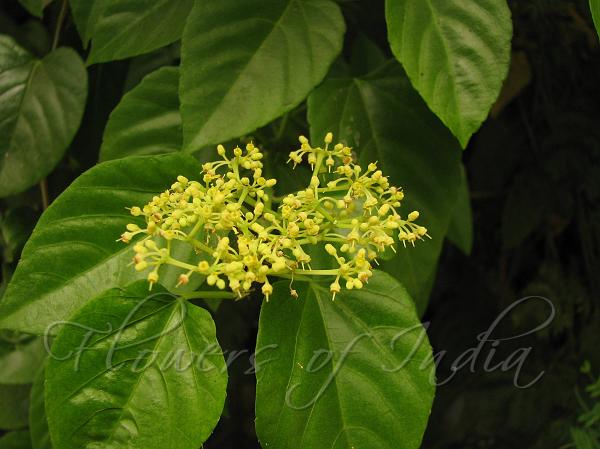|
| Princess Vine |
|

|

| File size | 755042 |
| Original date | 5/18/14 11:09 AM |
| Resolution | 2048 x 1536 |
| Flash | Flash did not fire, auto |
| Focal length | 6.0mm |
| Exposure time | 1/250s |
| Aperture | 4.5 |
| Focus Distance | |
| Metering Mode | Multi-segment |
| Camera make | Canon |
| Camera model | Canon PowerShot S5 IS |
| Sensor type | OneChipColorArea |
|
|
|
|
Photo: |
Botanical name: Cissus verticillata Family: Vitaceae (Grape family)
Synonyms: Cissus ovata, Cissus officinalis, Cissus nitida, Cissus cordifolia
Synonyms: Cissus ovata, Cissus officinalis, Cissus nitida, Cissus cordifolia
Princess Vine is often a very large, woody vine,
frequently climbing over tall trees, the stems thick and tough, very
flexible. Leaves simple, on long or short leaf-stalks, oblong-ovate to
rounded-ovate, sometimes very asymmetric, 4-16 cm long, blunt to
tapering, rounded to heart-shaped at the base, coarsely or finely
sawtoothed, usually densely velvet-hairy but sometimes almost hairless.
Flowers are borne in small or large, stalked cymes, usually dense and
shorter than the opposing leaves, sometimes lax and open, velvet-hairy.
Flowers green or yellowish green; fruit spherical-obovoid, black at
maturity, 1-seeded, about 6 mm long in the dry state. The vine produces
many long aerial roots that dangle loosely from the tree branches or
sometimes strike root in the ground. The vines exhibits a great deal of
variation in the hairiness and leaf form, as a result of which lot of
varieties were named. Princess Vine is native to Latin American
region.
Medicinal uses: The modern medicinal usages
come from Brazil and include: antipyretic (the herb in Brazilian
ethnomedicine) and anti-inflammatory applications; against epilepsy (or
at least as an anticonvulsive); externally: in haemorrhage and
abscesses.
The modern medicinal usages
come from Brazil and include: antipyretic (the herb in Brazilian
ethnomedicine) and anti-inflammatory applications; against epilepsy (or
at least as an anticonvulsive); externally: in haemorrhage and
abscesses.
Medicinal uses:
 The modern medicinal usages
come from Brazil and include: antipyretic (the herb in Brazilian
ethnomedicine) and anti-inflammatory applications; against epilepsy (or
at least as an anticonvulsive); externally: in haemorrhage and
abscesses.
The modern medicinal usages
come from Brazil and include: antipyretic (the herb in Brazilian
ethnomedicine) and anti-inflammatory applications; against epilepsy (or
at least as an anticonvulsive); externally: in haemorrhage and
abscesses. | Identification credit: Prashant Awale | Photographed in Mumbai, Maharashtra. |
• Is this flower misidentified? If yes,